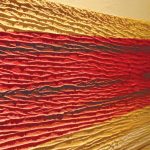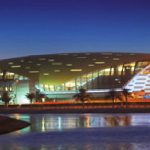-
An ‘Introverted Extroverted’ House
July 2012
Creating an elegant and comfortable modern home while staying within a client’s budget, is often a challenge to the Architect. However, this house is the perfect example which shows that overcoming this challenge is indeed possible.
By Manori Wijesekera | Photography Indika De Silva
Located in the quiet semi-urban suburb of Minuwangoda, nestled down a quiet country lane that is gradually being built up, we found the home of Dr Renuke and Chandrika Silva. It’s an “introverted extrovert” house, with an open and transparent concept within the high enclosed walls, which provided privacy and minimal intrusion from outside the enclosure.
“The client’s brief to us was to give them a modern home that still had some traditional elements and provided maximum ventilation and a serene environment,” said Marini Samaratunga, the Architect. The couple had differing ideas and needs, and the Architect had extensive meetings and consultations over a period of time to ensure both points of view were incorporated into the design.
The core design concept was to create a transparent house, with open spaces within and without. Modern, geometric shapes define the house, while a traditional steeped roof and natural finishes brought in the traditional element.
The house borders a spacious garden on three sides. This was no mean achievement, on a 15-perch plot. “Our clients were both keen gardeners and wanted to allow nature to be allowed indoors, so a large garden space was essential,” said Archt. Marini.
They also wanted water to be an element of the design. However, as the design progressed it was obvious that a pragmatic approach to maintenance was essential and the initial design of a “floating house” with water bordering and flowing into the house, had to be replaced with still water ponds at the entrance and a water feature inside the house.
“Even now, the dramatic effects of sunlight on water that we spoke about during the design stage, is seen in their home and enjoyed by them. They feel the house seems to change with the changes in the light,” said Archt. Marini.
Most of the openings are demarcated with steel bars, and there is no glass, merely woven rattan blinds (bata pelali) to reduce the harsh sunlight and protect against the rain. This allows for maximum cross ventilation, as well as for birds and squirrels to freely wander in and out. An open air terrace on the upper floor, originally planned to be covered in grass but now tiled, also provides a place to entertain and enjoy the outdoors, especially in the cool evenings.
“Because the site didn’t have any prominent features on which we could focus, we created small feature items within the house and garden,” said the Architect. The main entrance has a dramatic feel with a double entrance spanned by a timber bridge with lighting underfoot creating dramatic shapes at night. The doorway painted black creates a sense of depth as you enter the house. The still water on each side of this entrance, gives a sense of calmness and serenity.
The features continue within the house. A small inner courtyard bordering the indoor pond and water feature has a long grilled window which allows effective ventilation while also bringing in light. A sliding feature doorway was created, separating the kitchen and pantry. Upstairs, a wooden ladder emerges from the TV Lounge going up into an attic area with open grills and creating another interesting feature within the living space. Transitions are demarcated with a cement border, whether it be the transition from one texture to another, or from one space to another.
Outdoors, the well that was dug to provide water to the house was designed as a prominent feature with a geometric design and stylised iron grill work to create a modern well. The doorway leading into the office room downstairs was made into a feature with a short bridge covered by a high roof, upon which sits an oversized cement pot, lit up at night to bring in a dramatic element to the garden.
The core design concept was to create a transparent house, with open spaces within and without.
During both the design and the construction process, a key focus of the Architect was staying within the stipulated budget. Compromises and changes were made during construction, with the finishes and materials being routinely evaluated against the budget. “We had to avoid luxury finishes, but we were still able to create dramatic and elegant finishes using low-cost material in a creative way,” recalls Archt. Marini. Among these are the samara-painted textured walls in the courtyard and around the interior garden walls, a cement-rendered ceiling soffit on the ground floor, simple lighting fixtures and details.
And so, the completed house perfectly suited the lifestyle of its owners, and more importantly to them, stayed within their budget. “The client was extremely pleased, not only with the design and the elegance of their home, but also that they did not have to take any loans or be in debt at the end of the construction,” recalls Archt. Marini.
Principal Architect / Architectural Firm: Marini and Pulathisi Architects
Project Architect: Marini Samaratunga
Total Area of Site: 15 perches
Total Floor Area: 2470 Sqft
Building Footprint: 1472 Sqft (5.4 perches)
Period of Construction: 18 months
Date of Completion: December 2007
Contractor: Udayanga Builders
Client: Dr Renuke and Chandrika Silva



















